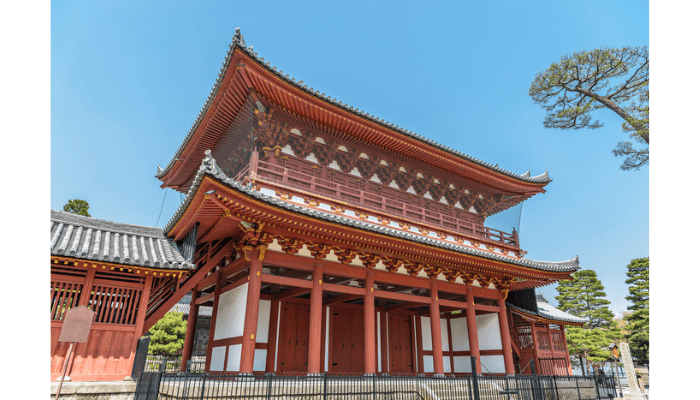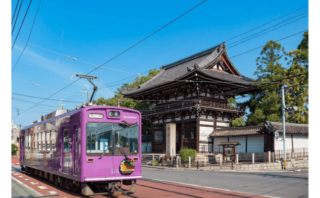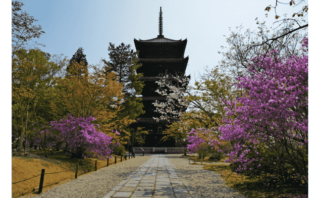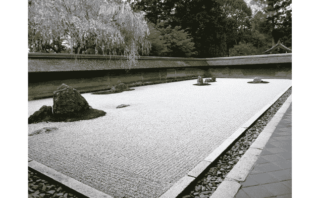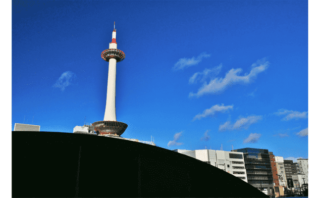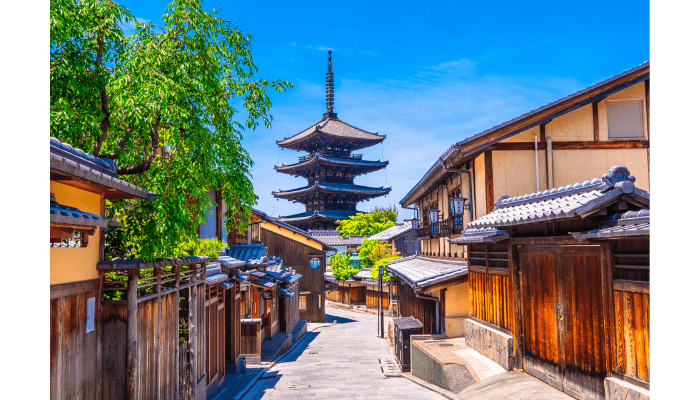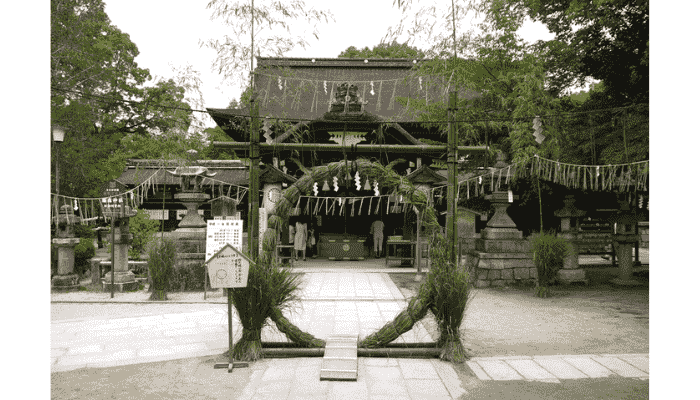Located in the Hanazono area of Kyoto’s Ukyo Ward, Myoshin-ji is a vast temple complex with so much to explore that you might not know where to start.
One of the most famous highlights of Myoshin-ji is the Ceiling Dragon in the Dharma Hall, painted by the Edo-period master artist Kano Tan’yū. This powerful and vividly detailed artwork is considered one of the most impressive dragon paintings in Kyoto and is a must-see.
But Myoshin-ji has much more to offer beyond the Ceiling Dragon. From its deep history to its stunning autumn foliage, there are plenty of hidden gems to discover.
In this article, we’ll introduce Myoshin-ji’s history, must-see attractions, and the best time to visit for autumn leaves.
Use this guide to make the most of your visit to Myoshin-ji!
What is Myoshin-ji?
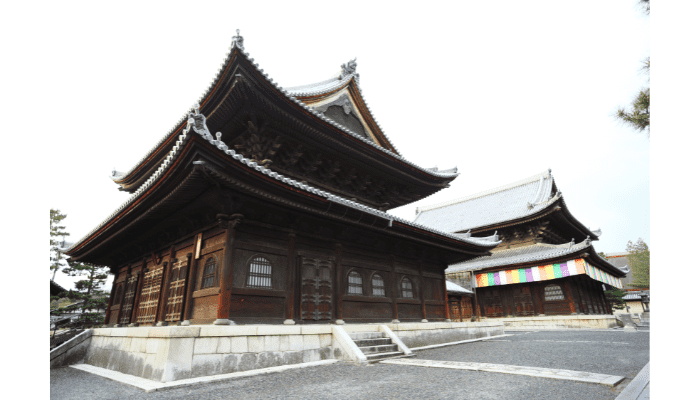
Among Kyoto’s many temples, Myoshin-ji stands out as one of the largest. It is the head temple of the Myoshin-ji school of Rinzai Zen Buddhism, which has 3,400 affiliated temples across Japan.
There are about 6,000 Rinzai Zen temples in the country, and more than half of them belong to the Myoshin-ji school. The sect also has over 6,000 monks, making it one of the largest Buddhist organizations in Japan.
Within its vast grounds, Myoshin-ji has many sub-temples (tatchu), and exploring them all would take a considerable amount of time. Interestingly, Ryoan-ji, a UNESCO World Heritage Site famous for its Zen rock garden, is actually an offsite sub-temple of Myoshin-ji.
Myoshin-ji
- Address: 1 Myoshinji-cho, Hanazono, Ukyo-ku, Kyoto
- Map: [Google Maps]
- Access: About a 5-minute walk from Hanazono Station on the JR Sagano Line (San’in Main Line)
- Phone: 075-466-5381
- Hours:
- 9:00 AM – 12:00 PM, 1:00 PM – 3:30 PM (ticket sales)
- Guided tours available every 20 minutes
- Admission Fee:
- Adults: ¥700
- Elementary & Middle School Students: ¥400
- Official Website: [Myoshin-ji]
The History of Myoshin-ji
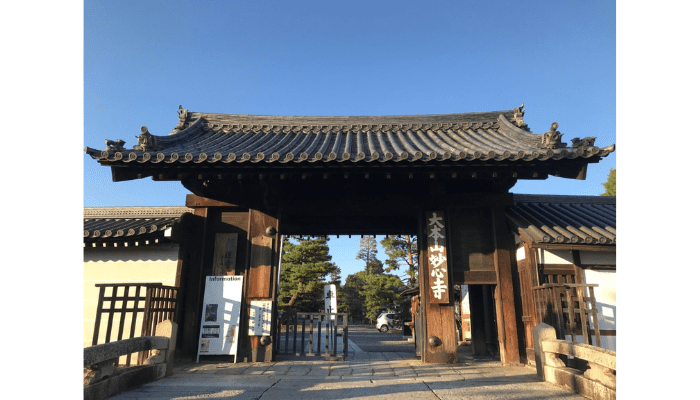
The origins of Myoshin-ji date back to the Kamakura period (1185–1333).
As the head temple of the Myoshin-ji school of Rinzai Zen Buddhism, it was officially founded in 1337. Rinzai Zen itself is one of the three major Zen Buddhist schools in Japan, introduced by the monk Eisai.
The site where Myoshin-ji now stands was originally an imperial villa belonging to Emperor Hanazono. Later, when the emperor abdicated and became a monk, the villa was converted into a Zen temple. The area’s name, Hanazono, actually comes from Emperor Hanazono’s title.
During the Muromachi period (1336–1573), Myoshin-ji faced turbulent times. Ouchi Yoshihiro, a powerful warlord with close ties to the temple, rebelled against Ashikaga Yoshimitsu, the shogun at the time. As a result, Myoshin-ji suffered repression from the shogunate. To make matters worse, the temple was severely damaged during the Onin War (1467–1477), a major conflict that devastated Kyoto.
However, Myoshin-ji was eventually restored by imperial decree from Emperor Go-Tsuchimikado. Today, it stands as one of the most significant Zen temples in Kyoto, preserving its long and eventful history.
How to Get to Myoshin-ji
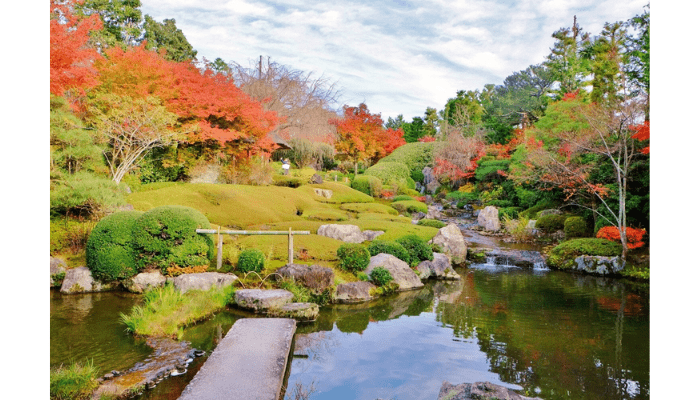
Myoshin-ji is located in Ukyo Ward, Kyoto, not far from Arashiyama, one of Kyoto’s most famous sightseeing areas. Many visitors include Myoshin-ji as part of their Arashiyama itinerary.
The temple is easily accessible from various parts of Kyoto. You can take the Randen (Keifuku Electric Railway) from Arashiyama or the JR Sagano Line (San’in Main Line) from Kyoto Station.
Here are the nearest stations and bus stops:
- By train: JR Hanazono Station
- By bus: Kyoto City Bus “Myoshinji Kitamon-mae” or “Myoshinji-mae”
- By Randen: Myoshinji Station
Now, let’s go over the best routes from Kyoto Station, Shijo Kawaramachi, and Arashiyama.
From Kyoto Station
By Train (Fastest Option)
- Take the JR Sagano Line (San’in Main Line) from Kyoto Station.
- Get off at Hanazono Station (about 12 minutes).
- Walk 5 minutes to Myoshin-ji’s South Gate.
By Bus (Direct but Slower)
- Take Kyoto City Bus Route 26 (bound for Kitano Hakubaicho / Ninna-ji / Yamagoe).
- Get off at “Myoshinji Kitamon-mae” (about 30 minutes).
- Walk 2 minutes to Myoshin-ji’s North Gate.
From Shijo Kawaramachi
By Kyoto Bus
- Take Kyoto Bus Route 62, 63, 65, 66, or 67.
- Get off at “Myoshinji-mae” (about 30 minutes).
- Walk 4 minutes to Myoshin-ji’s South Gate.
Note: Kyoto Bus is different from Kyoto City Bus. Look for buses with a red stripe to avoid confusion.
From Arashiyama
By Randen (Keifuku Electric Railway)
- Take the Randen Arashiyama Line from Arashiyama Station.
- Transfer at Katabiranotsuji Station to the Kitano Line.
- Get off at Myoshinji Station (about 15 minutes total).
- Walk 2 minutes to Myoshin-ji’s North Gate.
This route is convenient and scenic, making it a great choice if you’re visiting from Arashiyama!
Highlights of Myoshin-ji
Myoshin-ji is easily accessible from central Kyoto, making it a popular destination for visitors interested in experiencing the world of Zen. While the temple complex consists of 14 buildings, not all of them are open to the public. Some areas are restricted, so it’s a good idea to check in advance which temples are accessible before your visit.
Below are some of the must-see spots among the temples that are open to the public.
1. The Dharma Hall (Hatto)

One of the most striking structures in Myoshin-ji is the Hatto (Dharma Hall), built in 1656. It is designated as an Important Cultural Property due to its historical significance.
Inside, you’ll find the famous “Happo Nirami no Ryu” (The All-Seeing Dragon) painted on the ceiling. This impressive artwork, created by the renowned Kano Tan’yū, took eight years to complete.
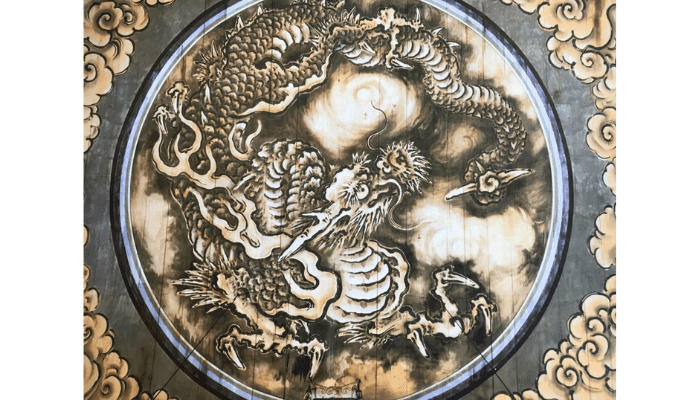
The dragon appears to be staring directly at you no matter where you stand in the hall, giving it its unique name. Despite its vibrant colors, the painting has never been restored, meaning you can see it in its original form from the time it was created.
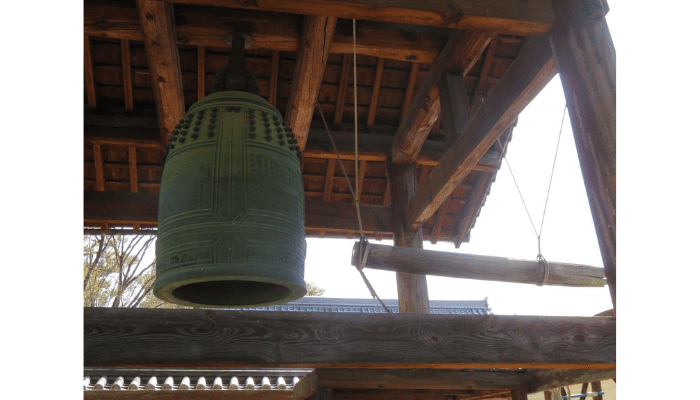
Another notable feature of the Dharma Hall is the Oshikicho Bell, the oldest bell in Japan. This bell, originally cast in 698, is mentioned in Tsurezuregusa, one of Japan’s three great essays. It was once housed in the temple’s bell tower but was later moved inside the hall for preservation.
Visiting the Hatto allows you to experience the rich history and powerful presence of Myoshin-ji firsthand.
2. Taizō-in
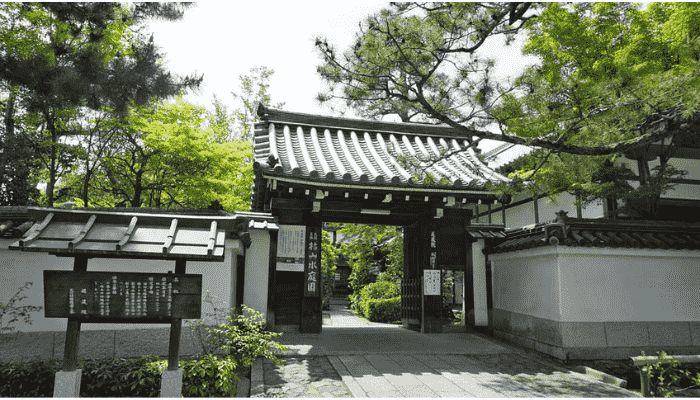
Taizō-in was originally founded in 1404 by the noble Hatano Shigemichi on Senbon-dori Street. It was later relocated to the Myoshin-ji temple complex by a prominent Zen monk.
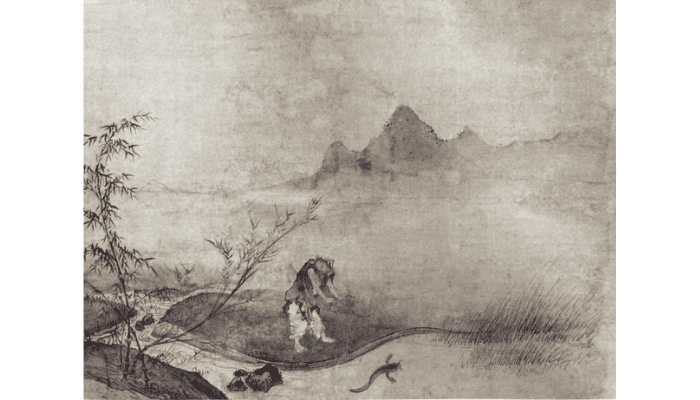
One of the most famous treasures of Taizō-in is the Hyōnen-zu, a National Treasure and an iconic example of early ink wash painting in Japan.
This painting was created in response to a Zen riddle posed by Ashikaga Yoshimochi, the 4th shogun of the Ashikaga shogunate:
“Can you hold down a slippery catfish with a smooth, round gourd?”
The artwork features a man holding a large gourd while staring at a catfish, creating a mysterious and thought-provoking scene. Above the painting, 31 Zen monks wrote poems offering their own interpretations of the riddle.
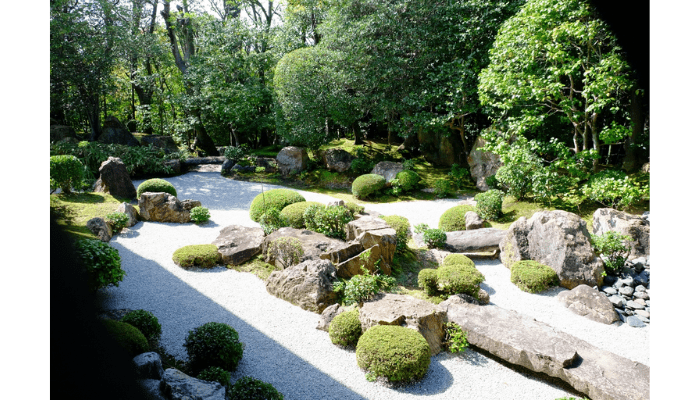
Another highlight of Taizō-in is the Motonobu Garden, named after the artist Kanō Motonobu. This beautifully designed Zen garden features evergreen trees such as yabutsubaki (wild camellia), pine, podocarpus, and mock orange, maintaining its serene beauty throughout the year.
3. Keishun-in
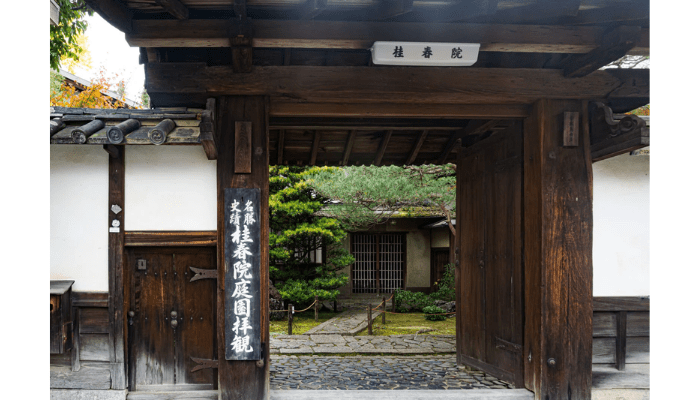
Founded in 1598 during the late Azuchi-Momoyama period, Keishun-in is a small sub-temple within the Myoshin-ji complex. Despite its modest size, it is home to the Keishun-in Garden, a Nationally Designated Place of Scenic Beauty, making it the temple’s most famous attraction.
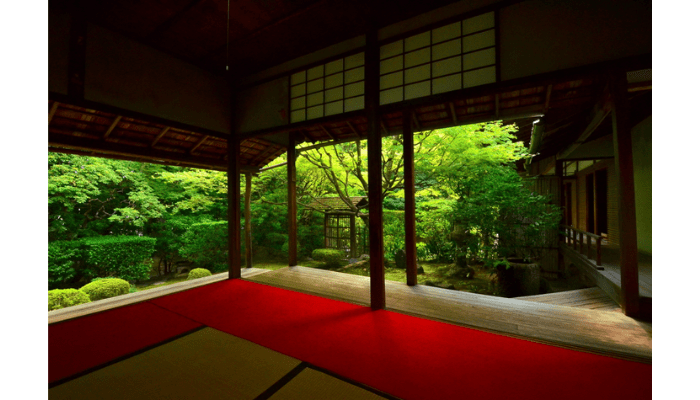
The garden consists of four distinct dry landscape gardens:
- Seijō-no-niwa (Garden of Purity)
- Wabi-no-niwa (Garden of Simplicity)
- Shii-no-niwa (Garden of Contemplation)
- Shinnyo-no-niwa (Garden of Truth)
Each garden, designed in the Edo period, has its own unique atmosphere. While the vivid green moss enhances their beauty year-round, azaleas in spring and red maple leaves in autumn create stunning seasonal contrasts.
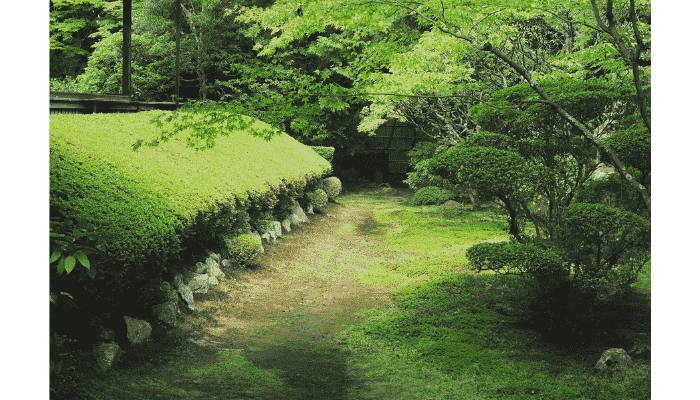
Among them, Shinnyo-no-niwa is the largest and features carefully sculpted shrubs, creating a dynamic and picturesque landscape. Visitors can walk through this garden, making it an ideal spot for photography. However, please note that entry into the other three gardens is not permitted.
Another highlight is the Kihakuan Tea House, associated with Fujimura Yōken, a disciple of Sen Sōtan, the grandson of Sen no Rikyū. Although usually closed to the public, it is open for viewing once a year, making it a rare and special experience for visitors.
4. Daishin-in
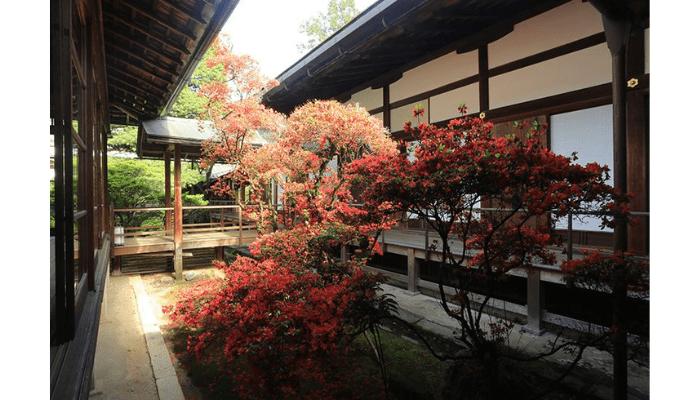
In the past, Daishin-in served as a lodging temple (shukubō) for monks training at Myoshin-ji and for traveling monks on their pilgrimage. The name “Tanga-ryō” refers to the idea that monks would arrive at the lodging in the evening (tan = dusk) and leave the next morning (ga = dawn).
Even today, visitors can stay overnight at Daishin-in, experiencing the simple and disciplined lifestyle of monks firsthand. It’s a unique opportunity to immerse yourself in Zen culture.
Daishin-in is also home to two dry landscape gardens:
- A-un Garden (阿吽庭)
- Kiri-ishi Garden (切り石の庭)
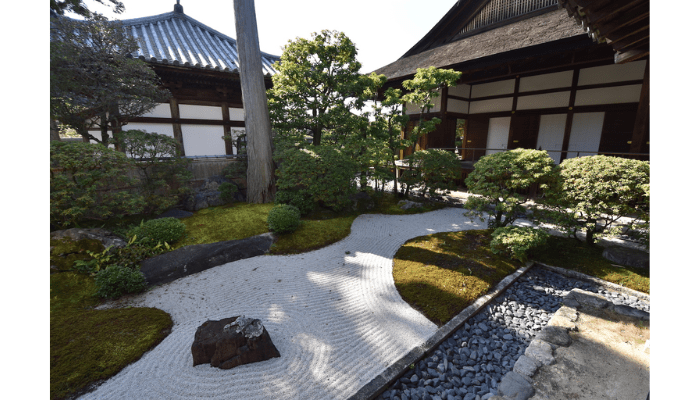
The A-un Garden, located in front of the study hall, is a long rectangular garden featuring white gravel, moss, and rocks arranged to depict a dragon ascending to the heavens. As you walk further into the garden, you’ll find a serene moss-covered area with 17 carefully placed stones. The meticulously raked gravel and tranquil atmosphere create a sense of purification and inner peace.
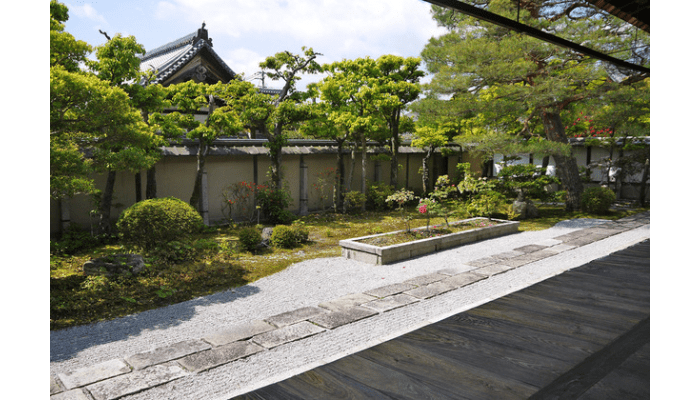
On the other hand, the Kiri-ishi Garden, located on the south side of the main hall, has a distinct stone-bordered design resembling a flower bed—a unique feature not commonly seen in other Zen gardens.
Autumn Foliage at Myoshin-ji
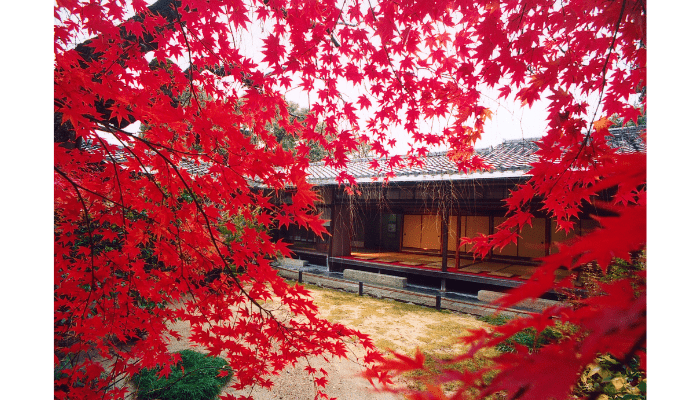
Kyoto is famous for its stunning autumn foliage, with many well-known spots attracting large crowds. However, Myoshin-ji remains a hidden gem for enjoying the fall colors in a more peaceful and relaxing atmosphere. Even during Kyoto’s peak foliage season, Myoshin-ji offers a more spacious and serene experience compared to other popular locations.
The best time to see the autumn leaves at Myoshin-ji is from early to late November.
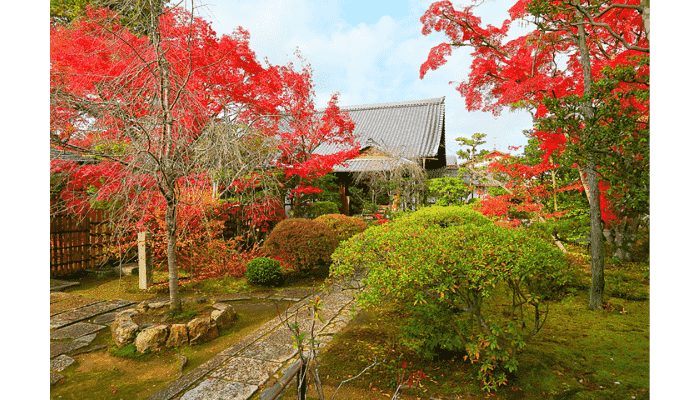
One of the most beautiful places to enjoy the autumn colors at Myoshin-ji is the roji (tea garden) of Daiho-in. The vivid red maple leaves create a breathtaking scene, making it a highlight of the season. Although Daiho-in is normally closed to the public, it opens exclusively during the fresh greenery season in spring and the autumn foliage season.
The entrance fee includes matcha (green tea) and traditional Japanese sweets, allowing visitors to sit back, relax, and fully appreciate the beauty of the season.
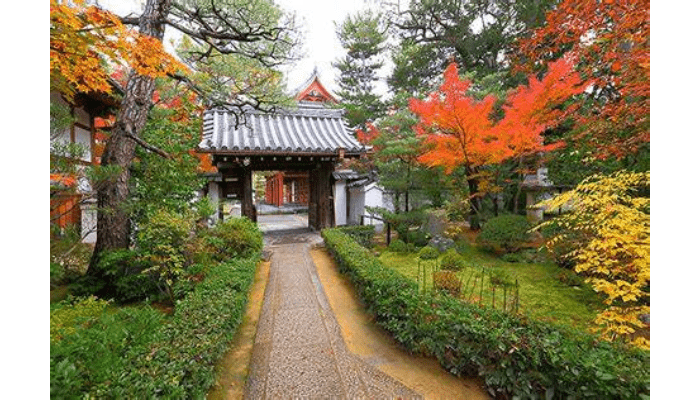
As mentioned in the highlights of Myoshin-ji, Taizo-in is another excellent spot to admire the autumn foliage. The famous Yoko-en Garden is surrounded by vibrant maple trees, which transform the landscape into a stunning blend of red, orange, and gold. The reflection of the colorful leaves on the pond’s surface creates an even more enchanting atmosphere.
If you’re looking for a tranquil and elegant way to experience Kyoto’s autumn, Myoshin-ji is the perfect destination.
Recommended Sightseeing Spots Near Myoshin-ji
The Hanazono area, where Myoshin-ji is located, is home to many historic temples and shrines. This area has a long history, and you can still find traditional Kyoto-style houses that add to its charm. Unlike Gion or Higashiyama, Hanazono is less crowded, making it perfect for a peaceful stroll.
Here are some recommended sightseeing spots that you can easily visit from Myoshin-ji by Randen (Keifuku Electric Railroad) or on foot.
1. Ninna-ji Temple

Originally built in 888 during the early Heian period, Ninna-ji Temple was founded by Emperor Koko’s wish. This prestigious temple is also a UNESCO World Heritage Site. Although much of the temple complex was destroyed during the Onin War, it was later rebuilt in 1646, restoring its original grandeur.

The spacious temple grounds are filled with historical and cultural treasures, but one of the main attractions is the Ninna-ji Goten (Palace Complex).
At Ninna-ji Goten, you can admire elegant traditional architecture, including the Shoin (study rooms) and Shinden (main hall). The South Garden and North Garden showcase beautiful Japanese landscaping, offering a serene atmosphere.

Another highlight is the fusuma-e (sliding door paintings) in the White Shoin (Byakushoin). These paintings were created by Japanese artist Seihan Fukunaga, who skillfully incorporated a variety of artistic techniques and classical motifs. The bold brushstrokes and intricate details create a striking contrast with the refined atmosphere of the study rooms.
Enjoy the timeless elegance of Ninna-ji and the artistic beauty of traditional Japanese paintings.
Ninna-ji
- Address: 33 Omuro Ouchi, Ukyo-ku, Kyoto
- Google Maps: Ninna-ji Temple
- Access: 3-minute walk from Omuro Ninna-ji Station (Randen Line)
- Phone Number: 075-461-1155
- Hours: 9:00 AM – 5:30 PM
- Admission Fee:
- Palace Complex: Adults ¥500 / Children ¥300
- Official Website: Ninna-ji Temple
2. Tōji-in Temple

Tōji-in Temple is the family temple of the Ashikaga clan, where generations of Ashikaga family members are enshrined. It was founded in 1341 by Ashikaga Takauji, one of Japan’s most famous samurai warriors and the first shogun of the Muromachi Shogunate.
This historic temple, deeply connected to one of Japan’s most powerful families, is within walking distance from Myōshin-ji.

One of Tōji-in’s most iconic features is its gigantic Daruma painting. You may have seen this striking red Daruma face in media before—it’s truly unforgettable.
This painting was created by Zen monk Seki Bokuō and depicts Bodhidharma, the founder of Zen Buddhism in China. Its bold brushstrokes and intense expression make it a must-see. Plus, photography is allowed, so be sure to capture this powerful image as a keepsake.
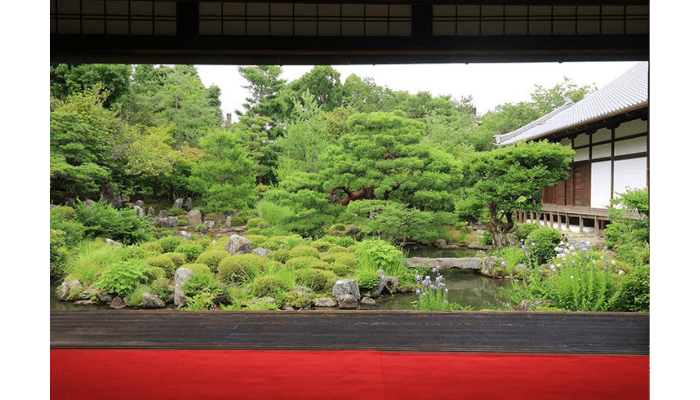
Tōji-in is also known for its beautiful seasonal flowers throughout the year:
Spring: Azaleas
Summer: Camellias
Autumn: Vibrant maple leaves
Winter: Nandina berries
No matter when you visit, the temple’s gardens offer a stunning seasonal display.
Tōji-in
- Address: 63 Tōji-in Kitamachi, Kita-ku, Kyoto
- Google Maps: Tōji-in Temple
- Access:
- 5-minute walk from Tōji-in Station (Randen Line)
- 8-minute walk from Tōji-in Minamimachi Bus Stop (Kyoto City Bus #10 or #26)
- Phone Number: 075-461-5786
- Hours: 9:00 AM – 4:30 PM
- Admission Fee: Adults ¥500 / Children ¥300
- Official Website: Tōji-in Temple
3. Ryōan-ji Temple
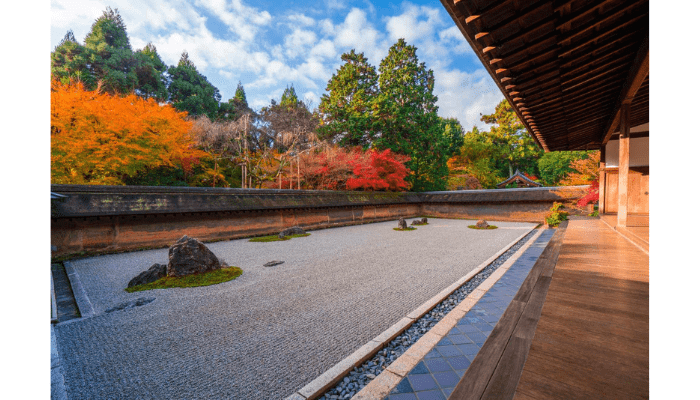
Ryōan-ji Temple is famous for its stone garden (karesansui), a dry landscape garden that attracts visitors from around the world. However, the garden’s origins remain a mystery—the exact date of its creation, its designer, and even the reasons behind its construction are unknown. This has led to many theories and interpretations, adding to its intrigue.
At first glance, it may seem like a simple Zen garden, but it actually incorporates optical illusions and careful design techniques.

The garden consists of 15 stones arranged on a bed of carefully raked white gravel. However, no matter where you stand, at least one stone is always hidden from view. This intentional design encourages deep contemplation, making the garden a symbol of Zen philosophy.
Additionally, the earthen wall at the back of the garden is designed to appear gradually lower as it recedes into the distance, creating an illusion of depth. This subtle trick makes the garden feel larger than it actually is.

Besides the stone garden, Kyōyō-chi Pond is another must-see attraction at Ryōan-ji.
- During the Edo period, the pond was a famous spot where mandarin ducks would gather.
- Today, it is known for its beautiful water lilies, attracting photographers and nature lovers.
Whether you come for the mystical stone garden or the serene pond, Ryōan-ji offers a peaceful retreat where you can experience the essence of Zen.
Ryōan-ji
- Address: 13 Ryōanji Goryōnomonshita-chō, Ukyō-ku, Kyoto
- Google Maps: Ryōan-ji Temple
- Access:
- 7-minute walk from Ryōan-ji Station (Randen Line)
- Right in front of “Ryōan-ji-mae” Bus Stop (Kyoto City Bus #59)
- Phone Number: 076-463-2216
- Hours:
- Mar 1 – Nov 30: 8:00 AM – 5:00 PM
- Dec 1 – Feb 28: 8:30 AM – 4:30 PM
- Admission Fee:
- Adults & high school students: ¥500
- Elementary & middle school students: ¥300
- Official Website: Ryōan-ji Temple
The area around Myōshin-ji Temple is rich in history, with historic buildings and place names that reflect Kyoto’s past. The more you explore, the deeper your appreciation for this area will grow.
It’s a must-visit spot for those who have been to Kyoto multiple times, offering a new perspective on the city’s heritage. Of course, first-time visitors can also enjoy the calm and authentic atmosphere of traditional Kyoto.
Since the paths within Myōshin-ji Temple are part of the local community’s daily life, visiting early in the morning provides a unique experience. You may notice small yet meaningful details that reveal the temple’s connection to everyday life.
Take your time and discover the many faces of Myōshin-ji, from its historical significance to its role in the local community!
▼ Related Articles for Kyoto Sightseeing
